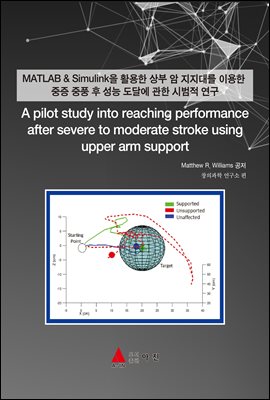
MATLAB & Simulink을 활용한 상부 암 지지대를 이용한 중증 중풍 후 성능 도달에 관한 시범적 연구(A pilot study into reaching performanc
- 저자Matthew R.Williams 저
- 출판사아진
- 출판일2020-07-14
- 등록일2020-12-21
- SNS공유


- 파일포맷PDF
- 파일크기8MB
- 공급사YES24
-
지원기기
PC
PHONE
TABLET
프로그램 수동설치
전자책 프로그램 수동설치 안내
아이폰, 아이패드, 안드로이드폰, 태블릿,
보유 1, 대출 0,
예약 0, 누적대출 8, 누적예약 0
책소개
Stroke effects millions of people each year and can have a significant impact onthe ability to use the impaired arm and hand. One of the results of stroke is the
development of an abnormal shoulder-elbow flexion synergy, where lifting the arm
can cause the elbow, wrist, and finger flexors to involuntarily contract, reducing
the ability to reach with the arm and hand opening. This study explored the effect
of using support at the upper arm to improve hand and arm reaching performance.
Nine participants were studied while performing a virtual reaching task under
three conditions: while the weight of their impaired arm was supported by a robot
arm, while unsupported, and while using their non-impaired arm. Most subjects
exhibited faster and more accurate reaching while supported compared to
unsupported. For the subjects who could voluntarily open their hand, most were
able to more swiftly open their hand when using upper arm support. In many
cases, performance with support was not statistically different than the unaffected
arm and hand. Muscle activity of the impaired limb with upper arm support
showed decreased effort to lift the arm and reduced biceps activity in most
subjects, pointing to a reduction in the abnormal flexion synergy while using upper
arm support. While arm support can help to reduce the activation of abnormal
synergies, weakness resulting from hemiparesis remains an issue impacting
performance. Future systems will need to address both of these causes of disability
to more fully restore function after stroke.
목차
제 1편 : SIMULINK 기본편1.1 SIMULINK의 시작 1
블록의 연결 5
블록 파라미터의 설정 7
시뮬레이션 파라미터 (Configuration Parameters)의 설정 8
시뮬레이션의 수행 9
블록 파라미터의 표시 9
복수 데이터의 표시 11
2.2 동적 시뮬레이션 13
이차 미분방정식 17
선형 상태변수 모델 23
DC 모터의 시뮬레이션 24
함수 블록의 사용 29
차분방정식(difference equation)의 모델링 34
Subsystem(부시스템)의 구성 37
제 2편 : 연구논문
A pilot study into reaching performance after severe to
moderate stroke using upper arm support
1. Introduction 41
2. Methods 42
4. Results 46
5. Discussion 49
6. Hand control 52
6. Conclusion 53
7. References 55

















